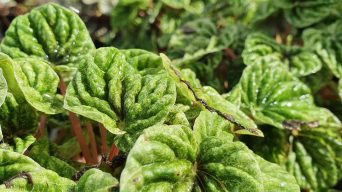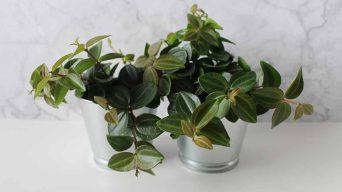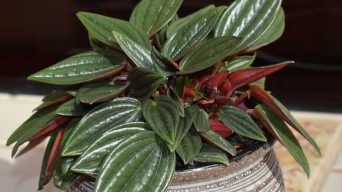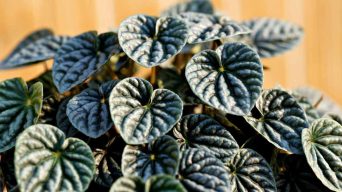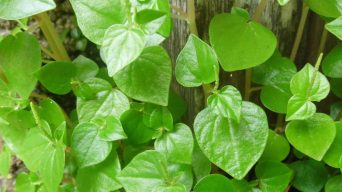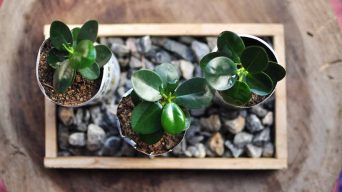An underwatered peperomia may show signs of wilted or curled leaves, dry soil, and discoloration. To revive the plant, keep a consistent watering schedule and check for issues such as low humidity or temperature fluctuations. It is also important to check if the roots are damaged and trim them if necessary.
Peperomia is a large genus of over 1,000 species of tropical plants found in the Americas.
The vast majority are native to South America, with only a few species found in North America, Africa, and Oceania.
Peperomia are popular houseplants because they are small, easy to care for, and have interesting foliage.
However, like all plants, they can suffer from problems if they are not cared for properly.
One common problem with peperomia is underwatering.
This can cause the leaves to become dry and crispy, eventually turning brown and dying.
Here’s what you need to know about underwatered peperomia plants, how to identify it, and how to prevent and treat it.
Why Is Underwatering A Problem?
Underwatering is a problem because it prevents plants from taking up the water and nutrients they need to survive.
Water is essential for plants because it helps them transport nutrients and minerals from the soil to the leaves.
It also helps them to keep their leaves moist, which is vital for creating energy and food through photosynthesis.
If a plant is not getting enough water, it will start to experience problems.
In severe cases, the plant will stop growing, the leaves will dry out and turn brown, and eventually, the plant will die.
What Causes Underwatering in Peperomia Plants?
There are a few different reasons why peperomia plants might suffer from underwatering.
The most common reasons are:
Not Enough Water
If you’re not watering your peperomia often enough, it will start to suffer from underwatering.
This is especially true if the indoor plant is in a pot with dry soil.
The best way to avoid this problem is to water your peperomia regularly, ensuring that the soil is always moist but not soggy.
Peperomia plants need about 1 inch of water per week.
Check the soil before watering if you’re unsure how often to water your Peperomia plant.
If the top inch of soil is dry, it’s time to water.
Poor Drainage
Peperomia plants need well-drained potting soil to thrive.
If the soil is too dense or doesn’t drain well, it can cause problems with underwatering.
When the soil is too dense, it doesn’t allow water to penetrate to the roots of the plant.
This can lead to the roots being starved of oxygen and water, eventually killing the plant.
To avoid this problem, make sure you’re using a potting mix that is light and well-draining.
To improve drainage, you can also add some perlite or sand to the potting mix.
Hot, Dry Weather
Hot, dry weather can also cause problems with underwatering.
When it’s hot and dry, the soil dries out more quickly.
You might need to water your peperomia more often to keep the plant healthy.
If you live in an area with hot, dry weather, ensure you water your peperomia at least once a week.
You might need to water more often if the weather is particularly hot or dry.
Too Much Sun
Peperomia plants need bright, indirect light to thrive.
If the plant is getting too much sun, it can cause the soil to dry out more quickly.
This can lead to underwatering.
To avoid this problem, ensure you’re giving your peperomia plant enough light without exposing it to direct sunlight.
The best way to do this is to place the plant where it will get bright indirect light.
You can also use a sheer curtain to filter out some of the direct sunlight if necessary.
Not Enough Humidity
Peperomia plants prefer high humidity.
If the air is too dry, it can cause the soil to dry out more quickly.
This can lead to underwatering.
Use a humidifier or place the plant on a pebble tray to increase the humidity around your peperomia plant.
You can also mist the plant with water to increase the humidity around it.
Not the Right Soil
Peperomia plants need well-drained, light potting soil to thrive.
If the plant is in heavy, dense soil, it can cause problems with underwatering.
To avoid this problem, make sure you’re using a potting mix that is light and well-draining.
You can also add some perlite or sand to the potting mix to improve drainage.
If you’re unsure whether your peperomia plant is in a suitable soil, you can test it by squeezing a handful of soil and squeezing it.
If the soil stays together in a ball, it’s too dense.
If the soil crumbles easily, it’s well-drained.
A potting mix that is light and well-draining is ideal for peperomia plants.
Root-Bound
Peperomia plants can suffer from underwatering if they are root-bound.
This means the plant’s roots have filled the pot and are growing out of the drainage holes.
When this happens, the roots don’t have enough room to grow and can’t absorb water properly.
This can lead to the plant suffering from underwatering.
To avoid this problem, ensure you’re repotting your peperomia plant every year or two.
This will give the roots room to grow and help the plant stay healthy.
Pest Damage
Pests can also cause problems with underwatering.
If pests are present, they can damage the plant’s roots and make it difficult for the plant to absorb water.
This can lead to the plant suffering from underwatering.
Inspect your peperomia plant regularly for signs of pests to avoid this problem.
If you see any pests, you can remove them by hand or use a natural pesticide to get rid of them.
Diseases
Diseases can also cause problems with underwatering.
Some diseases, such as root rot, can damage the plant’s roots and make it difficult to absorb water.
This can lead to the plant suffering from underwatering.
To avoid this problem, ensure you’re aware of the signs of disease and act quickly if you see any.
You can also try to prevent diseases by using a sterilized potting mix and avoiding overwatering.
How To Tell If Your Peperomia Is Underwatered
It’s essential to be able to tell if your peperomia plant is underwatered.
This way, you can take action to fix the problem and prevent the plant from suffering any further damage.
Signs of an Underwatered Peperomia
There are a few signs that you can look for to tell if your peperomia plant is underwatered.
These signs include:
1. Drooping Leaves
One of the most common signs of an underwatered peperomia is drooping leaves.
If the Peperomia leaves are drooping, it is not getting enough water.
The leaves droop because the plant cannot keep them upright due to a lack of water.
If you see this sign, it’s important to take action to water the plant.
2. Yellow Leaves
Another common sign of an underwatered peperomia is yellowing leaves.
The leaves can turn yellow for several reasons, but one of the most common is a lack of water.
When the plant doesn’t have enough water, the leaves can turn yellow and fall off.
If you see this sign, it’s important to take action to water the plant.
3. Brown Spots on Leaves
Brown spots on the leaves are another common sign of an underwatered peperomia.
Several things can cause these spots, but one of the most common is a lack of water.
When the plant doesn’t have enough water, the leaves start to dry out and turn brown.
If you see this sign, it’s important to take action to water the plant.
4. Brown Leaf Tips
Brown leaf tips are another common sign of an underwatered peperomia.
This is usually caused by the plant not getting enough water.
When the plant doesn’t have enough water, the leaves start dehydrating, and the tips turn brown.
If you see this sign, it’s important to take action to water the plant.
5. Curling Leaves
Curling leaves is another common sign of an underwatered peperomia.
When the plant doesn’t have enough water, the leaves can start to curl up.
The plant is trying to conserve water by curling the leaves.
If you see this sign, it’s important to take action to water the plant.
6. Dry and Cracked Soil
If the soil around your peperomia plant is dry and cracked, it’s a sign that the plant is not getting enough water.
When the soil is dry, it can crack and pull away from the sides of the pot.
This can make it difficult for the plant to absorb water.
If you see this sign, it’s important to take action to water the plant.
7. Wilting Leaves
If the leaves of your peperomia plant are wilting, it’s a sign that the plant is not getting enough water.
The leaves can wilt for several reasons, but one of the most common is a lack of water.
When the plant doesn’t have enough water, the leaves can wilt and fall off.
If you see this sign, it’s important to take action to water the plant.
8. Leaf Drop
If the leaves of your peperomia plant are falling off, it’s a sign that the plant is not getting enough water.
Several things can cause leaf drop, but one of the most common is a lack of water.
The leaves can fall off when the plant doesn’t have enough water.
If you see this sign, it’s important to take action to water the plant.
9. Soft and Limp Stems
If the stems of your peperomia plant are soft and limp, it’s a sign that the plant is not getting enough water.
The stems can become soft and limp when they don’t have enough water.
This can make the plant unstable and can cause the leaves to droop.
If you see this sign, it’s important to take action to water the plant.
10. Slow growth
If your peperomia plant is not growing as quickly as it should be, it’s a sign that it is not getting enough water.
When the plant doesn’t have enough water, it can’t grow as quickly and can become stunted.
If you see this sign, it’s important to take action to water the plant.
How To Save an Underwatered Peperomia
If you think your peperomia plant is underwatered, there are a few things you can do to save it.
1. Water the Plant Deeply and Evenly
When you water an underwatered peperomia, it’s important to water deeply and evenly.
This means watering the plant until the water comes out of the drainage holes.
It’s also crucial to water evenly so that all parts of the plant get the same amount of water.
2. Use Room Temperature Water
When you water an underwatered peperomia, it’s important to use room temperature water.
Hot or cold water can shock the plant and damage the roots.
Room temperature water is the best way to water an underwatered peperomia.
3. Avoid Overwatering
Once you’ve watered your underwatered peperomia, it’s important to avoid overwatering.
Overwatering a peperomia can cause the roots to rot and can kill the plant.
It’s important to only water the plant when the soil is dry.
4. Use a Humidifier
If the air around your peperomia plant is too dry, it can cause the plant to dry out.
To help prevent this, you can use a humidifier.
A humidifier will add moisture to the air and help keep your peperomia plant healthy.
5. Move the Plant to a Humid Location
If the air around your peperomia plant is too dry, you can try moving the plant to a more humid location.
A bathroom or kitchen is a good option.
You can also try placing the plant on a tray of pebbles and water.
The water will evaporate and help keep the air around the plant humid.
6. Improve the Soil Drainage
If the soil around your peperomia plant is too dense, it can cause the plant to dry out.
You can add some perlite or sand to the soil to improve the drainage.
This will help the water drain more quickly and prevent the plant from becoming oversaturated.
7. Repot the Plant
If the pot you’re using is too small, it can cause the roots to become cramped.
This can make it difficult for the plant to take up water and cause it to dry out.
If you think your pot is too small, you can try repotting the peperomia plant into a larger one.
8. Be Patient
If you’ve taken all the steps to save your underwatered peperomia, patience is essential.
It can take a while for the plant to recover.
But if you’re patient and give the plant the care it needs, it will eventually start to grow again.
How To Prevent Underwatering a Peperomia Plant
Peperomia plants are very easy to care for, but they can suffer from underwatering.
Here are some tips to prevent this from happening:
- Make sure you’re using a well-draining potting mix. Peperomias need a lot of drainage, so a standard potting mix won’t do.
- Water your Peperomia when the top inch of soil is dry to the touch. Peperomia plants are susceptible to overwatering, so letting the soil dry out in between waterings is essential.
- Use filtered water or rainwater if possible. Peperomias are sensitive to chemicals and minerals in tap water, so filtered or rainwater is best.
- Don’t let your Peperomia sit in water. If you’re using a saucer under your pot, empty it after each watering.
- Use a moisture meter to check the soil moisture level before watering. This will help you know how much and how often to water your Peperomia plant.
- If you’re having trouble keeping your Peperomia plant alive, try using a self-watering pot. These pots have a reservoir that slowly waters the plant, so you don’t have to worry about underwatering.
- Keep an eye on the weather. If it’s been particularly hot or dry, your Peperomia plant will need more water than usual.
- If you’re still having trouble, try moving your Peperomia to a shadier spot. Peperomias prefer indirect sunlight, so too much sun can stress the plant and cause it to dry out.
Hopefully, these tips will help you prevent underwatering your Peperomia plant!
Final Thoughts
Peperomia plant care is pretty straightforward to follow.
These plants are very drought tolerant, so you won’t have to worry about watering them too often.
Just make sure to keep an eye out for signs of underwatered peperomia, and be sure to give them a good drink when they need it.
Peperomia plants are low-maintenance and are a great addition to any indoor space.
With the proper care, they can even flower!
So if you’re looking for a plant that is easy to take care of and looks great, then a peperomia plant might be just what you need.


